
The Himalayas of India: Ladakh and Dharamsala,
Summer 2008
Ladakh - Shanti Stupa, Moravian Church, Reflective Lakes, Nomads, and
Mountains
Page 3 of 16
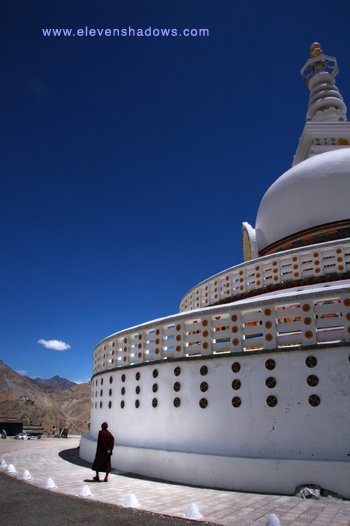 A
Ladakhi pilgrim circumambulates the Shanti Stupa, located high above Leh.
Although still not fully acclimatized, I was happy to be here, happy for the
clean air and the gorgeous views, and happy that I was feeling strong. A
Ladakhi pilgrim circumambulates the Shanti Stupa, located high above Leh.
Although still not fully acclimatized, I was happy to be here, happy for the
clean air and the gorgeous views, and happy that I was feeling strong.Afterwards, I climbed back down and met up with Tom at Mentonkling Cafe, eating a delicious vegetable biryani and chicken Afghani. I emailed home to Lisa a third time. Waylon, our cat, was sick with cancer and dehydrated. I felt sad and awkward to be so far away from Lisa and Waylon. Initially excited with the trip, I had booked it for six weeks. But now, that seemed too long. Although this length of time creates wonderful "RESET" button of sorts, with India perhaps the best country at having you live in the moment, now it felt too long. |
 After
emailing, I walked up to the Moravian Church in Leh. After all, the
Moravian Church was where the diary of a Christian monk stating that Russian
explorer Nicolas Notovitch, who had visited Hemis Monastery in the 1880s and
been allegedly given the translation of a manuscript that Jesus had come to
the Himalayas, had been kept. The diary had vanished, although Dr.
Fida Hassnain had fortunately photographed it prior to its disappearance. After
emailing, I walked up to the Moravian Church in Leh. After all, the
Moravian Church was where the diary of a Christian monk stating that Russian
explorer Nicolas Notovitch, who had visited Hemis Monastery in the 1880s and
been allegedly given the translation of a manuscript that Jesus had come to
the Himalayas, had been kept. The diary had vanished, although Dr.
Fida Hassnain had fortunately photographed it prior to its disappearance. |
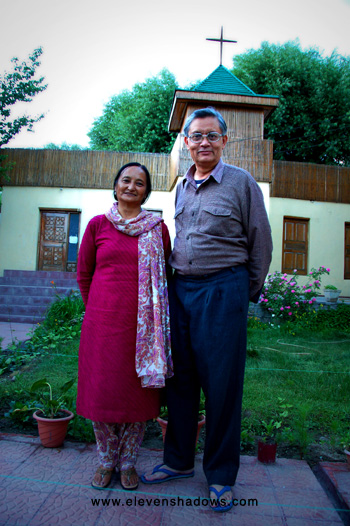 Entering
the gates, I knocked on the door. Entering
the gates, I knocked on the door."Hello, " I said, "is Pastor Elijah Gergan here?" "Yes, that's me," the man replied, looking friendly but slightly puzzled, "but how did you know my name?" "I, uh, saw your name on the door over there," I answered. He laughed a little, and looked visibly relieved. He sat me down and his wife immediately offered tea. I explained that I was a photographer, and inquired about the diary indicating that Notovitch had been to Leh and Hemis. The pastor was familiar with the diary, but said, "No, it is not here." He said it was stolen 40 years ago, and that he had been there for just 27. He referred to Notovitch as "the Russian fellow" and said that many things were stolen 40 years ago. He also said that people showed up from time to time inquiring about the diary. He told me about the Desert Rain Cafe, which the Moravian Church ran, intending to provide a place for children of the school that they run to go for rest, cookies and drinks, movies, music, and games. And indeed, when I went there, they had all that, although the prices were expensive and mostly foreigners were there. "You know, there's no parks or benches in Leh, " he remarked, "and no toilets. Nowhere for kids to relax." Pictured here is Pastor Gergan and his wife in front of the church. I found both to be very hospitable and friendly, with a good sense of humor. Before I left, they invited me to a church service. I would go to this fascinating service a couple of weeks later. |
 2
July - The
next day, we took off for the remote lake of Tso Moriri
with a 23-year old Ladakhi driver nicknamed Delek from Alchi. The road followed
the brown, churning Indus River for quite a distance, and the weather was
warm to hot, although cloud cover would send the temperature plunging
instantly. 2
July - The
next day, we took off for the remote lake of Tso Moriri
with a 23-year old Ladakhi driver nicknamed Delek from Alchi. The road followed
the brown, churning Indus River for quite a distance, and the weather was
warm to hot, although cloud cover would send the temperature plunging
instantly.
We stopped briefly at a barren stop called Chumathang, which had hot springs right on the shore of the Indus, bubbling away. Tom stuck his hand in one and instantly yanked his hand away, yelling, "Geeez, that's hot!!!" Shortly after Chumathang, we crossed the Indus onto a smaller road, stopping occasionally for beautiful sites, such as this lovely house and its radiant yellow flowers before continuing higher and higher towards the lake. |
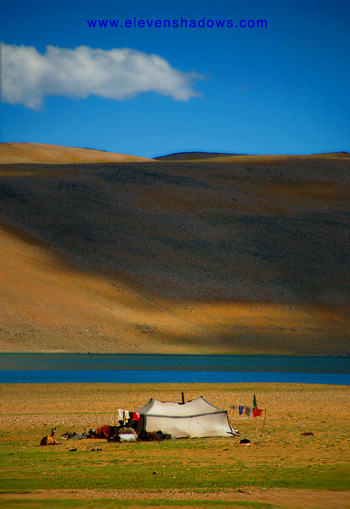 Along
the way to Tso Moriri high up in the Himalayas, we stopped along the
windswept mountains to observe Tibetan nomads herding sheep and goats. Along
the way to Tso Moriri high up in the Himalayas, we stopped along the
windswept mountains to observe Tibetan nomads herding sheep and goats. |
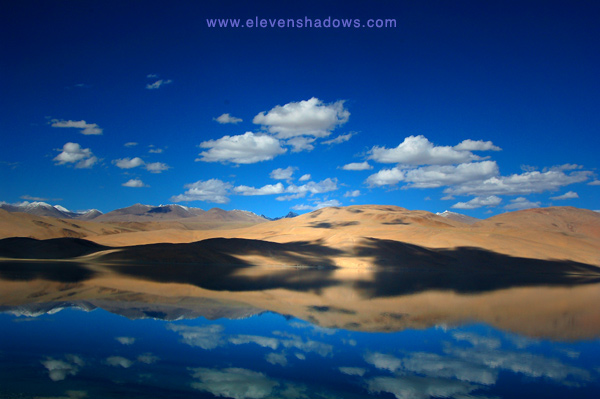 We
finally arrived at the reflective waters of Tso Moriri, near the border of
Tibet and at an oxygen-sapping altitude of 4500 meters (about 14,700 ft.).
The water, a deep blue, mirrored the sky. We
finally arrived at the reflective waters of Tso Moriri, near the border of
Tibet and at an oxygen-sapping altitude of 4500 meters (about 14,700 ft.).
The water, a deep blue, mirrored the sky. |
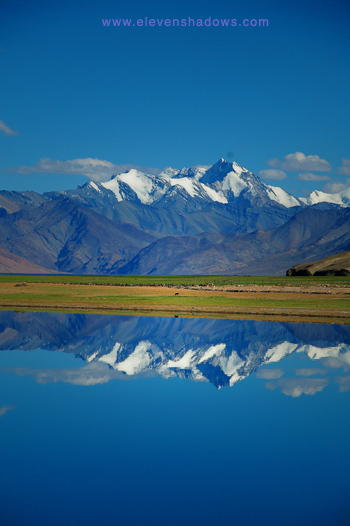 The
mirror lake of Tso Moriri, high up in the Himalayas. Delek, our
driver, pointed to the still waters and said that no fish live in the lake.
We did, however, see ducks. The
mirror lake of Tso Moriri, high up in the Himalayas. Delek, our
driver, pointed to the still waters and said that no fish live in the lake.
We did, however, see ducks.On the drive up, I asked Delek about winters in Alchi, where he lives in Ladakh. In particular, I asked him what he eats besides tsampa (barley flour, a sort of doughy porridge, often mixed with the exceedingly salty yak butter tea) and chang (barley beer) and bread. He replied that his family often ate dried apricots and apples, yak meat and yak cheese. ~~~~ The last time Tom and I came to Ladakh, we had sampled some of the chang from a two different Ladakhi farmers. One was wretched, the other delicious. Unfortunately, the driver we had who took us to Pangong Tso rather liked his chang as well. He drank copious amounts of it, at one point, stumbling into a wet ditch in the evening. But in the morning, still full of mud from his fall, he'd begin drinking again. I was assigned with the job of sitting up front and making sure he wouldn't nod off. At a stop, I finally took his bottle of chang and hid it in a farmer's stable. Fortunately, this time, we had Delek, who was very responsible. I'd end up going on three road trips with him as the driver. |
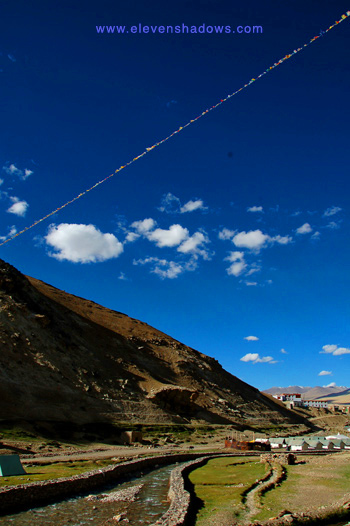 After
admiring the still blue waters of Tso Moriri, we drove up to the third camp.
We put our belongings in a tent cabin, and while Tom was resting, I went for
a walk back towards the lake, admiring what has to be the longest string of
prayer flags I've ever seen, strung across a broad valley up from the lake. After
admiring the still blue waters of Tso Moriri, we drove up to the third camp.
We put our belongings in a tent cabin, and while Tom was resting, I went for
a walk back towards the lake, admiring what has to be the longest string of
prayer flags I've ever seen, strung across a broad valley up from the lake.And although the air had been still, as the sun began to set behind some clouds, sudden cold winds began, whipping at the tent cabins, which stood strong. Just minutes before, my walk had been hot, but now the cold winds peeled the warmth away. I had a warm jacket, though, and this was the only evening in which I ever wore it on the entire trip. Tom, however, was deeply affected by the 4500 meter altitude, and suffered from headaches, stomachaches and nausea. He had, unfortunately, reached a new low. Three Italians staying in the same campsite were also suffering from similar symptoms and had no appetite. Of us five, I was the only one who felt okay, and ate the simple rice and dal meal that the camp provided from their kitchen tent. Using the outhouses was a chore due to the cold and wind. At night, I stumbled outside in the blackness, tripping over tent ropes, making my way carefully, only to find that the outhouses were so tiny that I couldn't close the metal door because my knees were in the way! I slept just a few hours due to the altitude. Tom fared even worse. |
 3
July - The
next morning, we were supposed to have gone horseback-riding for 2-3 hours.
Tom, however, felt awful. "I don't want to ride horses," he said, "I
want to go back to Leh." I canceled the horses, but tried to pay
him in full anyway. He declined, only taking half. Delek said,
"There's not much to see anyway," trying to make us feel better. We
had changed plans, and were going to visit another lake and go back by
another route. 3
July - The
next morning, we were supposed to have gone horseback-riding for 2-3 hours.
Tom, however, felt awful. "I don't want to ride horses," he said, "I
want to go back to Leh." I canceled the horses, but tried to pay
him in full anyway. He declined, only taking half. Delek said,
"There's not much to see anyway," trying to make us feel better. We
had changed plans, and were going to visit another lake and go back by
another route.However, on the way, we visited the modest Tso Moriri Monastery, pictured here. |
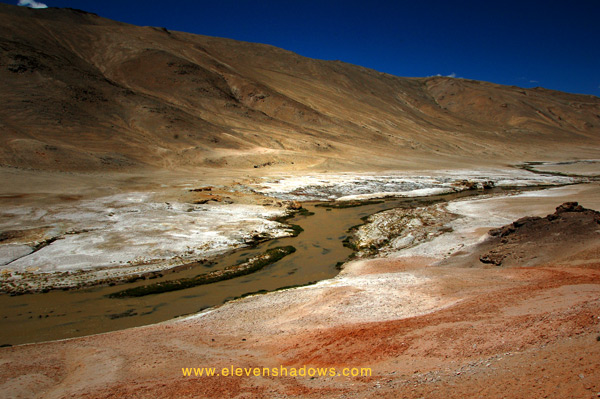 After
visiting the Tso Moriri Monastery, we headed towards Tso Kar, a small lake,
passing streams with white salt deposits along the way. After
visiting the Tso Moriri Monastery, we headed towards Tso Kar, a small lake,
passing streams with white salt deposits along the way. |
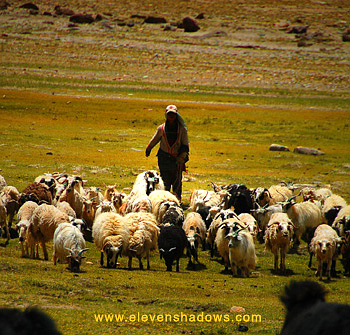 Throughout
the journey, we saw many Tibetan nomads herding goats and sheep, alternating
between the high grassy pastures to make certain they did not overgraze.
Delek said that the nomads were much more Tibetan in culture, although they
could still communicate somewhat. Throughout
the journey, we saw many Tibetan nomads herding goats and sheep, alternating
between the high grassy pastures to make certain they did not overgraze.
Delek said that the nomads were much more Tibetan in culture, although they
could still communicate somewhat. |
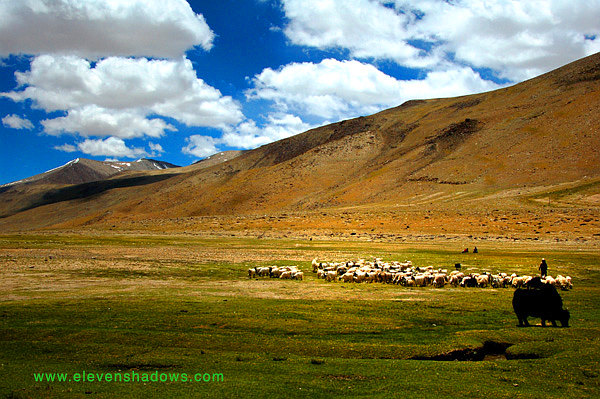 Seeing
the beautiful grassy pastures in the high airy peaks made me think about
what a vastly different life we have from theirs, and marveled at how they
have managed to keep their lifestyle despite the onslaught of jeeps and
money and different lifestyles that India brought. Seeing
the beautiful grassy pastures in the high airy peaks made me think about
what a vastly different life we have from theirs, and marveled at how they
have managed to keep their lifestyle despite the onslaught of jeeps and
money and different lifestyles that India brought. |
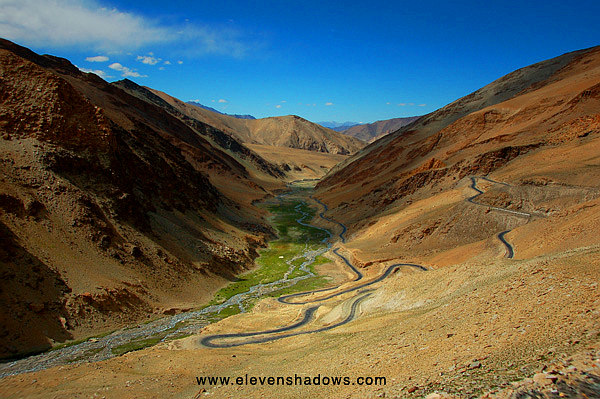 After
traversing absurdly bumpy rough roads, visiting the tiny Tso Kar lake, we
continued north on the Manali road, going over Taglang La Pass, the second
highest motorable road in the world, at 5359 meters (17,582 ft.). After
traversing absurdly bumpy rough roads, visiting the tiny Tso Kar lake, we
continued north on the Manali road, going over Taglang La Pass, the second
highest motorable road in the world, at 5359 meters (17,582 ft.).
After the bumpy road, I was concerned that the pass would be even worse. After all, eleven years ago, the passes were brutal, and were largely responsible for my back going into spasms in the cramped Suzuki jeeps we were in at the time. However, I needn't have worried. The roads were far smoother than before, and often two-lane roads, remarkable considering the harsh climate that continually tears at the road. |
 We
stopped off at Lato for a tea break. But instead, I wandered down to
look at this gorgeous stupa as Tom drank chai and Delek washed the Toyota. We
stopped off at Lato for a tea break. But instead, I wandered down to
look at this gorgeous stupa as Tom drank chai and Delek washed the Toyota. |
 And
Lato was a stopping place for truck drivers to take tea breaks and wash
their vehicles. And
Lato was a stopping place for truck drivers to take tea breaks and wash
their vehicles.We got back to Leh, and the lower altitude of "only" 3500 meters made us all feel better, especially Tom. I wandered around a little around the Main Bazaar, and we eventually ate at Tibetan Friend's Corner, with rather carb-heavy fare consisting of reggochey (dumpling soup) and momos (dumplings). |
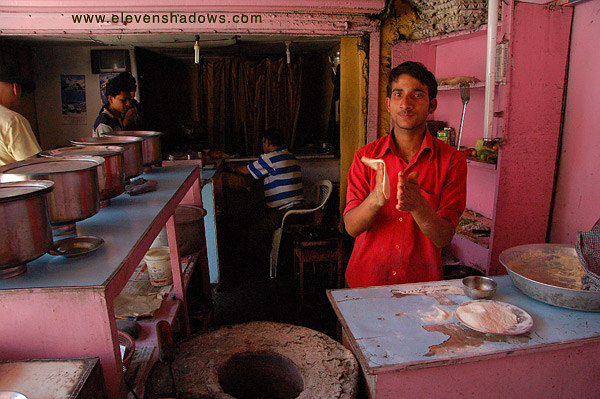 4
July - When suffering from the altitude, the most effective remedy is simply
to go a lower elevation, and so since
we had returned to the very "low" elevation of only 3500m. (11,500 ft.)
here in Leh, Tom felt much better. He regained his appetite. We ate
at a delicious Indian restaurant called Dogra Dhaba, and he wolfed down his
share of rajma dal and chapatis. And at 200RS ($5) for a four-course meal,
giant stacks of chapatis (Indian flatbread), and a large bottle of delicious mango juice, the
price is about right as well!! 4
July - When suffering from the altitude, the most effective remedy is simply
to go a lower elevation, and so since
we had returned to the very "low" elevation of only 3500m. (11,500 ft.)
here in Leh, Tom felt much better. He regained his appetite. We ate
at a delicious Indian restaurant called Dogra Dhaba, and he wolfed down his
share of rajma dal and chapatis. And at 200RS ($5) for a four-course meal,
giant stacks of chapatis (Indian flatbread), and a large bottle of delicious mango juice, the
price is about right as well!!We had eaten here eleven years ago, and still remembered how good the Punjabi-style food was. And so we were overjoyed to discover that it was still there in the same alleyway along Fort Road. Here in the photo, one of the cooks prepares fresh chapatis, as we celebrated the 4th of July India style. |
The Himalayas of India: Ladakh and Dharamsala, Summer 2008
Page 3 of 16
1 2 3 4 5 6 7 8 9 10 11 12 13 14 15 16
Eleven Shadows Travel Page
Contact photographer/musician Ken Lee